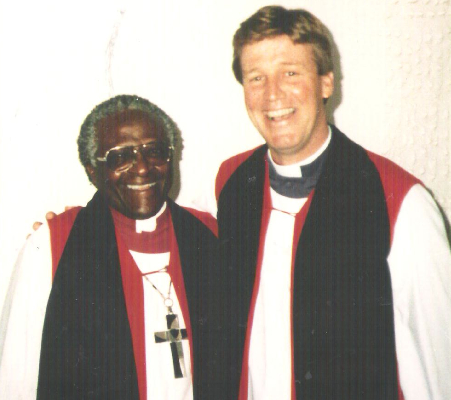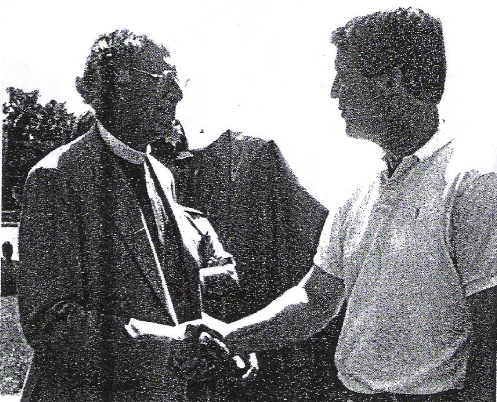Amidst pomp and ceremony, a total of 525 Bishops of the Anglican Church world-wide representing some 80 million Anglicans gathered at Canterbury, England, for the 12th Lambeth Conference.
The Conference, named after the first gathering of the Anglican Bishops world-wide at Lambeth Palace, takes place every ten years for purposes of prayer, conversations and resolutions in addressing the many problems and issues that confront the Church throughout the world.
At the conference this year was the Right Reverend Craig B. Anderson, Ph.D., Bishop of the Sioux Falls, representing the Diocese of South Dakota. Rev. Anderson is the son of Alvin and Glenna Anderson of Odessa.

Bishops Desmond Tutu, Archbishop of Johannesburg, and Craig Anderson, Bishop of the Diocese of South Dakota, finish vesting in the undercroft of Canterbury Cathedral, the Mother Church of Anglicanism, prior to the final Eucharistic Service for the Lambeth Conference.
Some highlights of this year’s three week Lambeth Conference included lively discussion and debate on the ordination of women as bishops within the Anglican Communion, the explosion of church growth within many of the third world nations especially Africa, growing concern for the increasing violence throughout troubled parts of the world, resolutions calling for an active response to environmental issues such as acid rain and the depletion of the ozone layer and lively debate concerning the Church’s teaching on human sexuality.
The plenary sessions of the more than 500 bishops were presided over by the Archbishop of Canterbury along with other Primates from the various provinces of the Anglican Church throughout the world. The proceedings of these plenary sessions were translated into English, French, Japanese, Spanish, Chinese, and various African dialects to name but a few.
Smaller working groups of slightly over 100 bishops were formed to address four major themes of this year’s Lambeth Conference: ecumenical concerns, dogmatic and pastoral concerns, mission and ministry, and Christianity and the social order. These working groups submitted resolutions, pastoral letters and other substantive legislation to the larger Lambeth Conference for discussion and action.
Many participants reported that the most meaningful part of the Lambeth Conference was the small study groups that met for an hour and half daily. These groups were made up from ten to twelve bishops who gathered together following daily Eucharist for Bible study, discussion and sharing aspects of ministry and cultural differences form their various perspectives and diocesan concerns.
Bishop Anderson says, “I felt that I took the Diocese of South Dakota to England with me.”
Bishop Anderson served on the Christianity and Social Order Task Force and was instrumental in working with other bishops such as Desmond Tutu in crafting legislation regarding AIDS, the political and social role of the Church, marriage, the family and human sexuality, environmental issues and the rights of minority persons, most especially, Native American persons here in the United States. Bishop Anderson’s small study group included two bishops from Japan, two from England, one from Australia, one from Canada, another United States bishop and an African bishop.
He shared the enthusiasm of many other bishops for these small group gatherings in noting that they provided an opportunity to learn about different cultures and issues confronting the Church in different parts of the world. He noted that a bonding took place in these groups that will undoubtedly continue in the months and years ahead in ongoing sharing and mutual prayer.
In additional to the theological reflection, long hours of debate and work on prepared statements, the bishops enjoyed one another’s fellowship at morning and evening tea as well as the many meals that were shared at the University of Kent in Canterbury.
Some additional highlights of the Lambeth Conference include a sit down lunch beneath tents on the beautiful grounds of Lambeth Palace and tea at Buckingham Palace with the Royal Family. In spite of a shower that interrupted the afternoon tea with the Queen, the Prince, as well as Lady Diane and Prince Charles, umbrella in hand, provided gracious hospitality to the bishops and their spouses.
Following Lambeth Conference Bishop Anderson and his wife. Lizbeth, and three children, Court 16, Megan11, and Ragnar 7, discovered their ethnic roots after having explored their religious roots in England by taking a trip to Norway and Sweden. They spent four days on the Sognfjord, the longest and deepest fjord in Norway, visiting relatives and the villages of Leikanger.
Following a tour of Norway they visited the southern coastal area of Skane, Sweden from where Bishop Anderson’s grandfather immigrated in the year1903 to western Minnesota. There the Andersons found several cousins and relatives and celebrated a large family reunion in the village of Loderup, a farming community some two miles from the southern most shore of Skane.
After a brief visit to Germany and France, the Andersons recently returned to Sioux Falls.
The Bishop noted that the trip was most inspirational and informative. Inspirational in experiencing the diversity and the unity of the Anglican Church world-wide while in procession for the opening and closing services at Canterbury Cathedral, the Mother Church of all Anglicans.
Informative in discovering the many unique problems that confront various parts of the Church world-wide and yet the common resolve to address these problems prayerfully and in faithful obedience to the Holy Scriptures and teachings of the Church. Having taken the Diocese of South Dakota to England the Bishop now hopes to share the wider Anglican Church with church members and friends here in South Dakota in the days and months ahead.

Informal farewells were exchanged between Archbishop Robert Runcie, Primate and head of the Anglican Church world-wide, and Bishop Craig Anderson of the Diocese of South Dakota on the final day of the Lambeth Conference held last month in Canterbury, England.
Bishop Anderson serves on the Governing Board of the National Council of Churches and was recently appointed as the Episcopal Church’s representative to the World Council of Churches to represent the Episcopal Church in the upcoming “Ecumenical Decade” focus of the World Council of Churches.
The Ortonville Independent – Wednesday, Oct. 26, 1988
